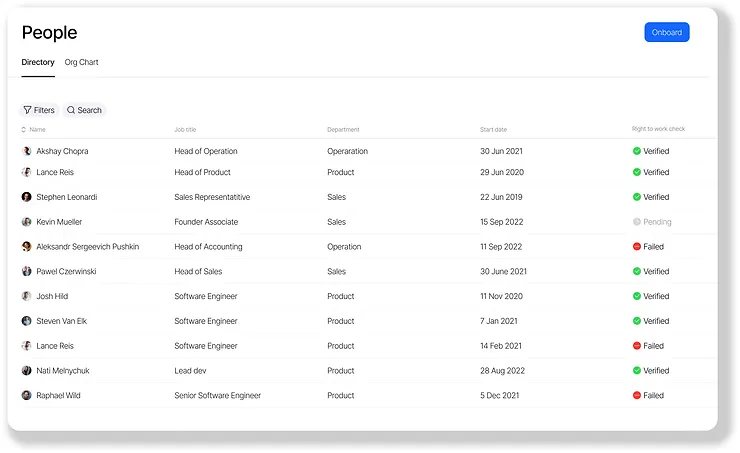Right To Work Checks: What changed in October 2022
Right to work checks may be complex and time-consuming, but are essential to avoid liability, penalties, and possibly even prison-time.

For the past two years due to COVID-19, the government has supported employers adapting to remote-working by digitising right to work checks. But from October 1, temporary COVID-19 measures will be replaced by new requirements for digital right to work checks.
You could face a civil penalty of up to £20,000
and criminal charges up to 5 years in prison
In order to continue fulfilling your legal duty as an employer, and to ensure you check prospective employees’ right to work properly, make sure you know what these changes involve.
In this article, we outline the essentials of right to work checks and what you need to know about the changes coming in on October 1.
What is a right to work check?
Employers have a legal duty to prevent illegal working, as set out in sections 15 – 25 of the Immigration, Asylum and Nationality Act 2006, UK . This means that employers must check that a job candidate has the right to work in the UK before employing and paying them.
This ‘check’ is called a ‘right to work check’ and employers must carry it out properly and thoroughly to avoid legal liability. This check involves investigating a prospective employee’s eligibility and right to work in the UK by looking at their immigration status and by validating their identity. Since October 1, employers need to do this via an Identity Service Provider (IDSP) that has been government-approved.
If an employee has a time-limited right to work in the UK, employers are also expected to carry out a follow-up check shortly before their entitlement to work is due to expire.
What are possible repercussions if you do not do right to work checks?
Employers have a legal duty to ensure that every employee has the right to work in the UK and face serious penalties in the case of non-compliance.
If you are found to have employed someone who does not possess the legal right to work in the UK, you could face a civil penalty of up to £20,000 for every illegal worker in your organisation.
You can avoid liability if you can show that you have carried out all the obligatory checks thoroughly and properly.
However, if you are found to have employed someone with the knowledge or ‘reasonable cause to believe’ that they didn’t have the right to work, you could face 5 years in prison as well as an unlimited fine.
What are the current requirements for right to work checks?
Right to work checks during COVID-19
In response to COVID-19 lockdown measures, the government introduced changes to how employers could carry out right to work checks remotely on March 30, 2020.
According to these temporary changes, employers could carry out their identity checks over video calls using scanned documents or photos of relevant identity documents instead of the original copies. These temporary measures remained in place until September 30, 2022.
Changes in effect since October 1, 2022
The temporary COVID remote right to work checks are no longer allowed from October 1, 2022. This means you can no longer be able to verify a prospective employee’s right to work using scanned copies of their documents over video call.
However, since the government wants to support employers in new post-pandemic working practices, accelerate recruitment and onboarding processes, encourage employee mobility and continue to enhance the security and integrity of these checks, there is still be a way to carry out a digital right to work check.
Since October 1, there are three ways to carry out a right to work check:
- Manual right to work check
- Digital right to work check using an IDSP
- Home Office online right to work check
Failure to carry out your right to work check in one of these three ways could result in a civil penalty as well as the loss of future ability to sponsor work visa applications for foreign nationals.
Employers are also be required to hold on to employee right to work records for two years after they leave their business.
What is an IDSP?
An IDSP is an digital Identity Service Provider that uses Document Validation Technology to carry out identity checks. IDSPs facilitate remote and digital right to work checks by allowing people to upload images of relevant documents instead of having to show their prospective employer the hardcopy originals.
Though it’s not mandatory to use a government-certified IDSP, it is recommended as this is a guarantee that they are be able to properly carry out the required checks.
You can find a list of certified IDSPs here.
How to prepare for the changes to right to work checks?
Right to work checks are a fundamental part of the recruitment and onboarding process. That’s why it is critical that you hardwire right to work checks into your standard processes to ensure that they are carried out compliantly.

The new requirements mean that your processes need to be come more digital and opting for an employee platform like Zelt can help your streamline this process.
Zelt has partnered with Zinc to help people teams supercharge their onboarding process by automating background checks, saving valuable time and improving employee experience.
Get started for free today.
How to check right to work yourself
Here’s a quick overview of which type of right to work check works for which type of candidate:
Digital right to work check using IDSP
The digital right to work check only works for potential employees who possess a valid British or Irish passport.
Online right to work check
The Home Office online right to work check service works for people who have an immigration status that can be checked online. You can quickly carry out a share code check by asking your employees to generate a code through the right to work service.
This includes holders of Biometric Residence Cards, Biometric Residence Permits, Frontier Worker Permits and anyone who has an immigration status that was issued under the EU Settlement scheme.
Manual right to work check
If a candidate does not fulfill the criteria for a digital right to work check and does not have an immigration status that can be checked online, you need to carry out a manual right to work check.
Manual right to work check checklist
If you’ve chosen to carry out a manual right to work check, here is what you need to do:
- Obtain relevant original documents from either List A or List B on the government website, such as a passport showing the person is a British Citizen or an Immigration Status Document that shows they have the right to indefinitely remain in the UK. You are no longer able to use an individual’s biometric residence card or permit.
- Check the validity of the documents & cross-check the identity of your prospective employee in-person. This means you need to confirm that the documents you’ve obtained are all genuine and that all details pertaining to the individual’s identity are correct and consistent. You also need to scrutinise the documents for any relevant expiry dates or work restrictions that may impact their right to work.
- Make a clear copy of every document and ensure that it cannot be tampered with or altered. Store the document securely either in an electronic format or as a hardcopy.
- Check whether you have a time-limited or continuous statutory excuse against liability.
- If you have obtained, checked and retained documents from list A, you gain a continuous statutory excuse. What this means is that you will have a continuous defence against legal liability for the duration of their employment, and will not need to carry out another right to work check.
- If you have used documents from List B groups 1 and 2, you will only gain a time-limited statutory excuse. This means that you will need to carry out a follow-up check at a relevant point in the future.
Digital right to work check checklist
You can also choose to carry out a right to work check using Identity Document Validation Technology as provided by an IDSP. As mentioned before, you don’t need to use a government-certified IDSP, but it is recommended.
- Find an IDSP. You can choose from the government-certified list or find an independent provider as long as you’re sure that they will be able to carry all the necessary checks properly.
- Ask your prospective employee to upload relevant documents.
- Verify the IDVT check. Make sure that the photos and personal details on the IDVT report line up with the person who you have employed.
- Keep a copy of the IDVT identity check for the duration of that person’s employment and for 2 years after they leave your business.
You will gain a continuous statutory excuse and will not need to carry out further checks.
Online right to work check checklist
The Government also has an online service through which you can conduct a right to work check. However, this won’t work for all prospective employees as not all types of immigration status can be verified online.
Here’s how to carry out an online right to work check:
- Head to ‘View a Job Applicant’s Right To Work’. Make sure you have the individual’s date of birth and ‘right to work share code’ ready.
- Verify that the photo that appears on the online right work check matches the person you have employed in-person.
- Keep a copy of the online right to work check for the whole of that person’s employment and for two years after they leave your business.
How to check EU, EEA and Swiss citizens’ right to work in the UK
As a result of Brexit, checking EU, EEA and Swiss Citizens’ right to work is a little more complicated than before. Remember that an EU passport or identity card no longer constitutes a right to work in the UK (except for Irish citizens).
Instead, EU, EEA and Swiss Citizens who lived in the UK pre-Brexit need to have applied through the EU Settlement Scheme for the right to live, work and study in the UK.
Anyone from those countries who now wants to seek employment in the UK will need you to sponsor their visa. And you need to obtain a special sponsor license in order to be able to hire anyone from outside the UK. In the majority of cases, you need to check EU, EEA and Swiss Citizen’s right to work using the Home Office Online check portal.
FAQs about right to work in the UK
Here are some of the most frequently asked questions about right to work checks in the UK.
What is changing from October 1, 2022 for right to work checks?
From October 1st 2022, remote right to work checks that were introduced under a COVID scheme will no longer be acceptable. Instead, employers will need to carry out right to work checks manually, using a IDSP or through the home office online service depending on the candidate’s immigration status.
How long does a right to work check take in the UK?
Right to work checks vary from employer to employer, so it’s impossible to give an exact time frame. It is possible to carry out and complete a right to work check in just a few days, but it depends on which method you choose to use.
When should a right to work check be done?
All UK employers must carry out a right to work check on any prospective employee before hiring them.
Is a NI Number a proof of the right to work in the UK?
Someone’s NI number alone is not enough to prove a right to work. As outlined by the government website, your prospective employees must provide you with either their biometric residence permit number, biometric residence card number, passport or national identity card in order for you to be able to carry out a proper right to work check.
When will an employee require a certificate of sponsorship?
The UK’s points-based immigration system requires that certain non-European Economic Area (EEA) nationals have a valid UK Certificate of Sponsorship (CoS) before they can apply for a visa to work or study.



